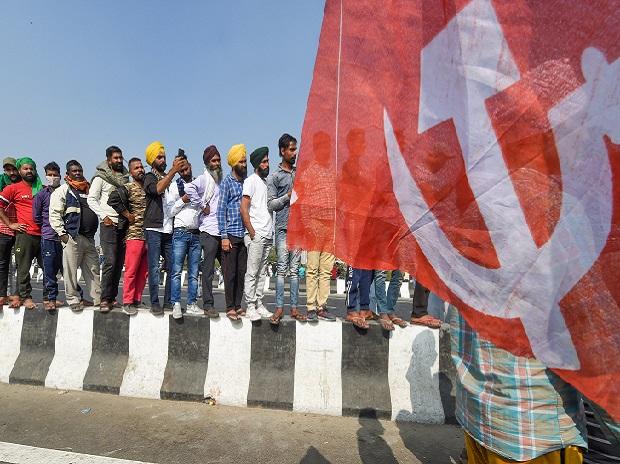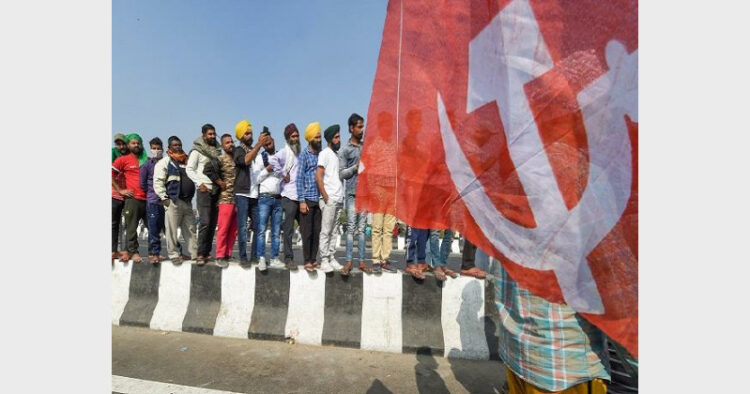Agrah Pandit

Punjab, once a bastion of Left ideology, has been witnessing a gradual shrinking of the political Left. Although there have been sporadic spotting of the Red flags during the ongoing farmers’ protests but this doesn’t signal the revival of the Left in Punjab—not for the time being, at least.
In the midst of Centre reaching out to farmers to address their genuine concerns, there were reports of the hijacking of farmer’s protests by radical elements—from Khalistanis to Communists. Many of the “farmer leaders” were not even farmers, and were reported to be affiliated to the Left political parties such as CPI (Marxist). Darshan Pal, the state president of Krantikari Kisan Union (KKU), for instance, is reportedly affiliated to CPI (Maoist). Hannan Mollah, another leader of farmer’s protests is 8 times MP from CPI (Marxist) and a former secretary of DYFI, the youth wing of the party. He is currenly a member of Central Secretariat of the party. Jagmohan Singh Patiala, a member of BKU (Dakaunda), is also liked to CPI (Maoist) as per a newspaper report. Nirbhay Singh Dudhike was associated with UCCRI (Marxist-Leninist). BKU(Krantikari) leader Surjeet Singh Phool is linked with Maoists and is in Amritsar jail. Farmers belonging to BKU (Ugrahana) have held placards demanding the release of riot-accused Umar Khalid and Sharjeel Imam.
The question is whether the political Left will be able to regain the long lost ground in Punjab, riding on a wrong cause and petty opportunism?
Punjab once used to be a harbinger and bastion of Radical Left, but has been witnessing a shrinking of the space for the political Left for many years now. The vote share for the Communist-Marxist combine in 2017 State Assembly election was a mere 0.4%—lower than even that of NOTA. Compare this with a vote share of 10.1% and winning of 15 seats during the 1977 assembly elections. Even at national level, there has been attenuation of the Left—from 23 seats in first general election (1951-52) to 5 Lok Sabha seats with a mere 2.33% vote share in 2019 general elections. Therefore, their petty opportunism is understandable. However, this is not the isolated case. Let’s have a glance at the brief history of communists in India.
A Brief History of Communist Movement in Punjab
The Left in Punjab was traditionally organised under Naujawan Bharat Sabha, the communist Party and Kirti Kisan movement. The suppression of Ghadar Movement by the British and the conclusion of First World War had led many erstwhile Ghadarites to join the radical Left. Most of the colonial Punjab’s early communist cadres traced their political pedigree to the Ghadar movement. After 4th Congress of Comintern, Ghadar Party accepted Marxism at its ideology. Communism provided a more consistent and widely accepted model of mass politics than Lala Har Dayalism.
And like every communist party, Communist Party of India, was by its constitution, ‘a section of the Communist International’. Initially, the communists had tried to bring anti-imperialism struggle under its sole ambit. Parroting the narrative received from their political masters sitting at Moscow, they termed Congress as a bourgeois party. They believed not in representative democracy based on Westminster model but on real democracy and in “overthrowing the British government in India by violent means”. There was severe crackdown on communist movement including the outlawing of 5 communist-socialist organisations in July 1934 by Punjab government.
However, in 1935, the CPI adopted the United Front line, which was mooted at 7th congress of Comintern. Consequently, they decided to make strategic common cause with Congress and Congress Socialist Party in anti-imperialist struggle. Lenin’s doctrine that there could be circumstances when the priorities of national liberation took precedence over the class struggle came handy. Furthermore, the radical undertones of Nehru made him acceptable to the Communists.
The build-up towards 1937 elections to the Provincial Legislative Assemblies further brought Congress and Communists together, especially in Punjab. The reason was that pro-landlord Punjab Unionist Party was too strong in colonial Punjab, Congress too weak and Communism too novice for parliamentary democracy, prompting the last two to give a united fight to the former. Communists could use Congress’ organisational structure and brand; Congress could use communists’ recent inroads into Punjab’s hinterland.
The elections of 1937 returned 13 Left-leaning representatives in Punajb’s 175-seat assembly. The radical left, now in opposition benches, used their position extensively to advance their propaganda and shame the government. In his very first appearance in the assembly, Punjab’s Communist leader Sohan Singh Josh doubted if the representative democracy were real and substantive as 76% of the population was refused the right to vote, and sermonised that Punjab should learn from the Russian example.
However, their assembly life was short-lived. Come second World War and Punjab had the largest number of communists and socialists behind bars. As one scholar has commented: “the radical left in the Punjab had enjoyed a relatively short-lived period when, as MLAs, they could operate openly. Like bees, they stung and then they seemed to have died… It was also a time of transformation because for the first time these years saw communists accepting, and working within, the constitutional framework constructed by the Raj.”
However, their life outside the constitutional framework was much more eventful. The communists were able to cause large-scale unrest amongst Punjab’s peasantry. Muzara movement was a demand for giving half of the produce to tiller followed by demands for land reform, ownership rights for the tenants, etc. During 1938-39, when peasantry was radicalised like never before, Section 144 was imposed on Punjab resulting in thousands of arrests and brutal lathi charges.
Communists Discredited
Just before the onset of Second World War, the Soviet Union and Germany entered into a non-aggression pact. This way, Germany could invade Poland in September 1939 followed by Soviet Union’s invasion into Finland in December 1939. Since Soviet Union and Britain were not on same page therefore the Communists, understandably, advocated continuing anti-imperialist struggle against the British raj. But then, in June 1941, Hitler invaded Soviet Union thus bringing Stalin and Britain on the same page against Nazi Germany.
Communists who had hitherto criticised Congress for not disrupting the war effort, now criticised them for disrupting it in the wake of Quit India resolution. The 16 jailed communist leaders of then-banned CPI gave a written undertaking of aiding to Britain’s war effort, if released. The ban on CPI was lifted in July 1942. Communists did their best to disrupt Quit India Movement. They even periodically submitted the ‘performance report’ in this regard to the British government. Their performance report, for instance in Punjab, boasted:
“…In every district we have held giant kisan conferences to wean people away from pro-Japan, pro-sabotage activities to our line of anti-fascist struggle for freedom…
Recruitment figures went up by 50,000 to 70,000…
We succeeded in checking the growing demoralisation in the army by propaganda among soldiers on leave in the Punjab. We checked a number of would-be deserters, made them stick to their posts…
We were the only Party who spoke against sabotage at a time when even the universities dared not talk against the ‘struggle’ …Through our intervention we prevented strikes after August 9, in spite of repeated attempts of the fifth column.
At Lahore 1,200 workers of the Mukand Iron & Steel Works, sorely affected by lack of mahagai wanted to come out on strike, and would have done so, had we not definitely persuaded them against it…
At Amritsar the entire textile mill workers population would have come out on strike, had we not been there to prevent this. Only two mills were on strike and only through our efforts were we able to persuade workers to go back in time.”
Role in Partition
To Marx, Hinduism was an ideology of “an oppressive and outworn society.” Further, India was “not a country properly speaking…merely a stretch of land with a meek conglomerate of peoples passively waiting for the next conqueror.” Stalin too wrote in a 1925 essay: “… in the case of a revolutionary upheaval in India many hitherto unknown nationalities, each with its own language and its own distinctive culture, will emerge on the scene.”
True to their ideology, Communist Party proclaimed, in words of Arun Shourie: “India is not one nation but a collection of several separate nationalities, many of them being oppressed nationalities… The Muslim League leadership plays an oppositional role vis-á-vis imperialism… Accordingly the Congress, it was said, must concede to the Muslims ‘the right to self-determination,’ ‘the right of autonomous state of existence… accompanied by the unconditional right to political secession.’”
They further proclaimed that “the right to secede should be given to all ‘nationalities’ – ‘Karnatakis’, Andhras, Tamils, Bengalis, Marathis, Punjabis, Sindhis, Baluchis, Pathans, to list just the specific ‘nationalities’ mentioned by the party as illustrations of its thesis. Even the formula put forth by Cripps did not envisage the balkanization of India that this ‘bold’ formula of the party, this ‘very simple solution’, as it put it, would have ensured.”
Present Situation
Communism-Marxism is virtually absent today in Punjab. The state which once was a hotbed of Left ideology in North India got a mere 44,000 votes in the latest assembly elections. The state which has produced the tall Communist leader Harkishan Singh Surjeet (General Secretary of the Communist Party of India 1992-2005) has witnessed considerable decline for Left ideology. Reasons are many.
In the last two decades, there have been at least 10 splinter groups of CPI and CPM in Punjab. The Green revolution made a dent into Left’s traditional vote base of farmers. Many of its comrades were killed during the insurgency phase. The emergence of BSP and AAP further dented its electoral prospects as did restrictions on student politics. Further, Punjabis are well-rooted in their religion and culture which is not always compatible with communism that sees things in terms of class and antipathy to religion. Sub-nationalism of Punjab is at odds with romanticised internationalism of Radical Left.
It is highly unlikely that Punjab would see any resurgence for the communist parties, in near future, despite the appearance of few red flags here and there during farmers’ protests. The political Left seems to not have done its homework. There are strong economic reasons to reform a shoddy farm sector. However, they are shooting from the shoulders of protesters (many of whom happen to be middlemen and rich farmers) who have provided them opposition and opportunistic platform. Trying to extract political capital by opposing a pro-farmer reform may well prove to be tactical mistake of the same league as their opposition to 2007 Indo-US civilian agreement or their other historical mistakes.













Comments